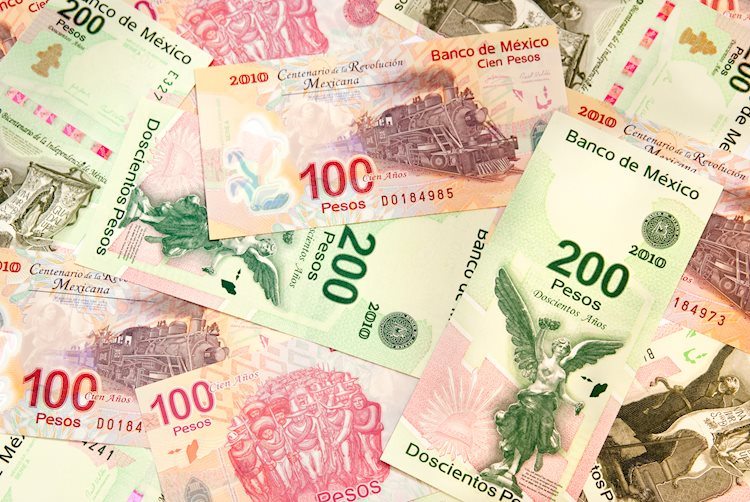- Mexican Peso declines as USD/MXN climbs over 1.40%, driven by expectations of further Banxico rate cuts.
- Cooling inflation in early September bolsters the case for a Banxico rate reduction at the September 26 meeting.
- Bloomberg survey: 20 of 25 analysts expect Banxico to cut 25 bps to 10.50%, with some predicting a 50 bps reduction.
The Mexican Peso tumbles against the Greenback on Wednesday as the latter appreciates sharply against most emerging market currencies. There are expectations for further easing by the Bank of Mexico (Banxico) at its September 26 meeting. This environment has sponsored a leg-up in the exotic pair. At the time of writing, the USD/MXN trades at 19.58, a gain of over 1.40%.
Mexico’s economic docket remained absent on Wednesday, but data revealed on Monday and Tuesday paint a mixed economic picture. In annual data, Economic Activity improved in July, but Retail Sales extended its agony to three consecutive months of registering negative readings.
On Tuesday, the Instituto Nacional de Estadistica Geografía e Informatica (INEG) announced that monthly and yearly inflation figures for September’s first half cooled.
The latest data set should allow Banxico to cut its interest rate by at least 25 basis points (bps) on Thursday. According to Bloomberg, 20 out of 25 analysts estimate that the central bank will lower borrowing costs to 10.50%. One expects rates to remain unchanged, and four estimate a 50 bps rate cut, following the Fed’s footsteps.
If Banxico eases its policy, that would be negative for the Peso. Hence, the USD/MXN could extend its uptrend, with traders setting their sights on the psychological 20.00 figure.
Christian Lawrence, senior cross-asset strategist at Rabobank, noted, “We see room for bouts of downside on the back of tactical carry trade flows during periods of vol suppression. Still, our base is for further MXN weakness over the coming months as reforms and US elections add to MXN risk premia.”
Meanwhile, data in the United States (US) show that although the economy is slowing down, most market participants estimate a soft-landing scenario. On Tuesday, the Conference Board (CB) revealed that Consumer Sentiment in September deteriorated and hit its lowest level since August 2021 at 98.7, down from 105.6.
Daily digest market movers: Mexican Peso dips amid scarce economic docket
- USD/MXN extended its rally on Banxico rate cut expectations, alongside the Greenback’s recovery.
- US Dollar Index (DXY), which tracks the buck’s performance against a basket of six peers, climbs 0.56% and exchanges hands at 100.91.
- Banxico is expected to lower borrowing costs by 175 bps toward the end of 2025, according to the swaps markets.
- Market participants had fully priced in a 100% chance of a 25 bps rate cut by the Fed. However, the odds for 50 bps of easing are 60.8%, according to the CME FedWatch Tool.
USD/MXN technical analysis: Mexican Peso slumps as USD/MXN surpasses 19.50
The USD/MXN resumed its uptrend on Wednesday and hit a daily high of 19.64 before stabilizing at current levels. Momentum favors further upside as the Relative Strength Index (RSI) is bullish.
The first key resistance level that buyers need to clear is the August 6 high at 19.61. Once surpassed, the next stop is 20.00, followed by the year-to-date (YTD) peak at 20.22.
On the flip side, if sellers drive USD/MXN below the September 23 low of 19.29, it will expose the confluence of the 50-day Simple Moving Average (SMA) and the September 18 low between 19.08 and 19.06.
Banxico FAQs
The Bank of Mexico, also known as Banxico, is the country’s central bank. Its mission is to preserve the value of Mexico’s currency, the Mexican Peso (MXN), and to set the monetary policy. To this end, its main objective is to maintain low and stable inflation within target levels – at or close to its target of 3%, the midpoint in a tolerance band of between 2% and 4%.
The main tool of the Banxico to guide monetary policy is by setting interest rates. When inflation is above target, the bank will attempt to tame it by raising rates, making it more expensive for households and businesses to borrow money and thus cooling the economy. Higher interest rates are generally positive for the Mexican Peso (MXN) as they lead to higher yields, making the country a more attractive place for investors. On the contrary, lower interest rates tend to weaken MXN. The rate differential with the USD, or how the Banxico is expected to set interest rates compared with the US Federal Reserve (Fed), is a key factor.
Banxico meets eight times a year, and its monetary policy is greatly influenced by decisions of the US Federal Reserve (Fed). Therefore, the central bank’s decision-making committee usually gathers a week after the Fed. In doing so, Banxico reacts and sometimes anticipates monetary policy measures set by the Federal Reserve. For example, after the Covid-19 pandemic, before the Fed raised rates, Banxico did it first in an attempt to diminish the chances of a substantial depreciation of the Mexican Peso (MXN) and to prevent capital outflows that could destabilize the country.
Read the full article here

